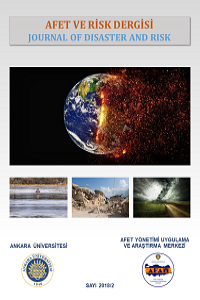Assessment of Climate Disaster Resilience In Dhaka City: A Case Study of Ward No. 28 of Dhaka South City Corporation
Öz
Dhaka is one of the fastest growing cities in the world, faces persistent urban environmental challenges. Environmental degradation, environmental pollution, flooding, high temperature, erratic rainfalls etc. on life and livelihoods of the city people have posed Dhaka a risky, vulnerable, unsustainable, unlivable and fragile city. In this context, this paper tries to measure resiliency through identifying Climate Disaster Resilience Index (CDRI) of ward no. 28 under the jurisdiction of Dhaka South City Corporation (Old Ward no. 64 of Dhaka City Corporation) considering five dimensions-Physical, Social, Economic, Institutional and Natural. This ward is representing the old Dhaka scenario which represents a segment of the capital of Mughal Bengal. There are some major factors under every dimension that have been considered to measure the index. By giving different weightage to different aspects finally CDRI has been measured for ward no. 28. The result shows that the overall average CDRI value for ward no. 28 is 2.65, which indicates that the natural disaster resiliency level is moderate. It also been suggested that by improving communication and accessibility, enforcing zoning and density control by the concerned Development Authority, partnership and collaboration with the people by social capital enhancement program; savings liked insurance programs; leveraging of existing strength in terms of external institutional networks, internal networks etc. can strengthen climate disaster resiliency in ward no. 28.
Anahtar Kelimeler
Dhaka Environmental Degradation Dhaka Climate Disaster Resilience Index (CDRI) Weightage Average Method
Kaynakça
- Alam, M. and Rabbani G., (2007). Vulnerabilities and responses to climate change for Dhaka. Environment and Urbanization, Vol. 19(1): 81-97.
- BBS, Population Census 2001 National Report, (2003). Bangladesh Bureau of Statistics, Ministry of Planning, Government Republic of Bangladesh, Dhaka.
- Godschalk, D. R. (2003). Urban Hazard Mitigation: Creating Resilient Cities, Natural Hazards Review, Vol 4(3):136-143.
- Mileti, D. (1999). Disasters by Design: A Reassessment of Natural Hazards in the United State, Joseph Henry Press, Washington, D.C.
- Parvin, G. A, and Shaw, R. (2011). Climate Disaster Resilience of Dhaka City Corporation: An Empirical Assessment at Zone Level. Risk, Hazards & Crisis in Public Policy, Vol. 2(2): 14.
- Shaw, R. & IEDM Team, (2009). Climate Disaster Resilience: Focus on Coastal Urban Cities in Asia. Asian Journal of Environment and Disaster Management. Vol 1:101-116.
- Krishnamurthy, R. (2011). Applying a Climate Disaster Resilience Index (CDRI) to enhance planning decisions in Chennai, India. Available from http://www.cseindia.org/userfiles/RamasamyKrishnamurthy.pdf (Accessed on 20 October, 2012).
Assessment of Climate Disaster Resilience In Dhaka City: A Case Study of Ward No. 28 of Dhaka South City Corporation
Öz
Dhaka is one of the fastest growing cities in the world, faces persistent urban environmental challenges. Environmental degradation, environmental pollution, flooding, high temperature, erratic rainfalls etc. on life and livelihoods of the city people have posed Dhaka a risky, vulnerable, unsustainable, unlivable and fragile city. In this context, this paper tries to measure resiliency through identifying Climate Disaster Resilience Index (CDRI) of ward no. 28 under the jurisdiction of Dhaka South City Corporation (Old Ward no. 64 of Dhaka City Corporation) considering five dimensions-Physical, Social, Economic, Institutional and Natural. This ward is representing the old Dhaka scenario which represents a segment of the capital of Mughal Bengal. There are some major factors under every dimension that have been considered to measure the index. By giving different weightage to different aspects finally CDRI has been measured for ward no. 28. The result shows that the overall average CDRI value for ward no. 28 is 2.65, which indicates that the natural disaster resiliency level is moderate. It also been suggested that by improving communication and accessibility, enforcing zoning and density control by the concerned Development Authority, partnership and collaboration with the people by social capital enhancement program; savings liked insurance programs; leveraging of existing strength in terms of external institutional networks, internal networks etc. can strengthen climate disaster resiliency in ward no. 28.
Anahtar Kelimeler
Environmental Degradation Climate Disaster Resilience Index (CDRI) Dhaka Weightage Average Method
Kaynakça
- Alam, M. and Rabbani G., (2007). Vulnerabilities and responses to climate change for Dhaka. Environment and Urbanization, Vol. 19(1): 81-97.
- BBS, Population Census 2001 National Report, (2003). Bangladesh Bureau of Statistics, Ministry of Planning, Government Republic of Bangladesh, Dhaka.
- Godschalk, D. R. (2003). Urban Hazard Mitigation: Creating Resilient Cities, Natural Hazards Review, Vol 4(3):136-143.
- Mileti, D. (1999). Disasters by Design: A Reassessment of Natural Hazards in the United State, Joseph Henry Press, Washington, D.C.
- Parvin, G. A, and Shaw, R. (2011). Climate Disaster Resilience of Dhaka City Corporation: An Empirical Assessment at Zone Level. Risk, Hazards & Crisis in Public Policy, Vol. 2(2): 14.
- Shaw, R. & IEDM Team, (2009). Climate Disaster Resilience: Focus on Coastal Urban Cities in Asia. Asian Journal of Environment and Disaster Management. Vol 1:101-116.
- Krishnamurthy, R. (2011). Applying a Climate Disaster Resilience Index (CDRI) to enhance planning decisions in Chennai, India. Available from http://www.cseindia.org/userfiles/RamasamyKrishnamurthy.pdf (Accessed on 20 October, 2012).
Ayrıntılar
| Birincil Dil | İngilizce |
|---|---|
| Konular | Çevre Bilimleri |
| Bölüm | Araştırma Makalesi |
| Yazarlar | |
| Yayımlanma Tarihi | 31 Ekim 2018 |
| Kabul Tarihi | 31 Ekim 2018 |
| Yayımlandığı Sayı | Yıl 2018 Cilt: 1 Sayı: 2 |

